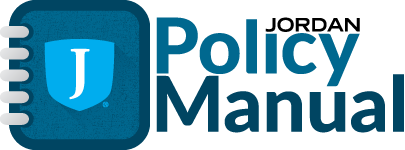- Effective 8/11/2020
- Revised 5/27/2025
- Board Directive
It is the policy of the Board to allow benefit eligible employees Postpartum Recovery/Parental Leave as indicated below according to Utah Code 53G-11-209. - Administrative Policy
-
- Definitions
For purposes of this policy, the following definitions apply:- Postpartum Recovery Leave: Leave the District provides to a postpartum recovery leave eligible employee to recover from childbirth that occurs at 20 weeks or greater gestation.
- Postpartum Recovery Leave Eligible Employee: An employee who:
- Receives benefits, including retirement and paid leave; and
- Gives birth to a child at 20 weeks or greater gestation.
- Parental Leave: Leave the District provides to a parental leave eligible employee to bond with a child or, in the case of a guardianship appointment, an incapacitated adult, including:
- The birth of the parental leave eligible employee’s child;
- The adoption of a child; or
- The appointment of legal guardianship of a child or incapacitated adult.
- Parental Leave Eligible Employee: An employee who:
- Receives benefits, including retirement and paid leave; and
- Is assuming a parental role with respect to the child or the incapacitated adult for which parental leave is requested; and
- Is the child’s biological parent;
- Is the spouse of the person who gave birth to the child;
- Is the adoptive parent of the child, unless the employee is the spouse of the pre-existing parent;
- Is the intended parent of the child born under a validated gestational agreement; or
- Is appointed legal guardian of the child or the incapacitated adult;
- Qualified Employee: An employee eligible for postpartum recovery leave or parental leave.
- Employees applying for Postpartum Recovery/Parental Leave must apply in Skyward Employee Access under the provision of DP322 – Family Medical Leave Act.
- A qualified employee shall receive up to three consecutive work weeks (up to 15 contract days) of postpartum recovery leave, to be used beginning on the date of birth unless a health care provider certifies that an earlier start date is medically necessary. This leave is in addition to any other leave for which the employee is already eligible. Medical exceptions may be given by Human Resources. For more information see policies DP324 NEG Sick Leave – Licensed and DP335 NEG Annual Leave – Licensed, DP326 NEG Sick Leave – Education Support Professionals, and DP335B Annual Leave – Education Support Professionals.
- A qualified employee shall receive up to three consecutive work weeks of parental leave (up to fifteen contract days).
- Parental leave may not be used before the day on which:
- The qualified employee’s child is born, unless a health care provider certifies that an earlier start date is medically necessary for postpartum recovery;
- The qualified employee adopts a child; or
- The qualified employee is appointed legal guardian of a child or incapacitated adult.
- Parental leave runs consecutively to postpartum recovery leave for an employee utilizing postpartum recovery leave.
- Parental leave may only be used within six months after the qualifying date listed in D. 1.
- Parental leave may not be used intermittently, unless a health care provider certifies that intermittent leave is medically necessary due to a serious health condition of the child.
- Parental leave runs concurrently with any leave authorized under the Family and Medical Leave Act according to District Policy DP322.
- Parental leave does not increase if a qualified employee:
- Has more than one child born from the same pregnancy;
- Adopts more than one child; or
- Is appointed legal guardian of more than one child or incapacitated adult.
- A qualified employee may not use more than three consecutive work weeks of parental leave within a contract year or single 12-month period, regardless of whether during that contract year or 12-month period, the qualified employee:
- Becomes the parent of more than one child;
- Adopts more than one child; or
- Is appointed legal guardian of more than one child or incapacitated adult.
- Parental leave may not be used before the day on which:
- Postpartum recovery/parental leave compensation
- A qualified employee shall be paid for contract days which the employee would otherwise have been under contract to work during the postpartum recovery or parental leave, but shall not be paid for non-contract days occurring during the leave.
- A qualified employee will not be compensated for any unused postpartum recovery or parental leave.
- A qualified employee shall provide the District notice at least 30 days before the day on which the qualified employee plans to:
- Begin using postpartum recovery or parental leave; and
- Provide a schedule of anticipated leave dates.
- The adoptive parent employee may decide to waive using parental leave in consideration for using other leave in DP324 NEG Sick Leave – Licensed or DP326 NEG Sick Leave – Education Support Professionals.
- The District:
- May not interfere with or otherwise restrain a qualified employee from using postpartum recovery or parental leave; or
- Take retaliatory action against a qualified employee for using postpartum recovery or parental leave.
- The District shall provide each employee with information regarding the qualified employee’s right to use postpartum recovery and parental leave.
- Questions about how this policy applies to an individual family situation should be referred to Human Resources.
- Definitions
